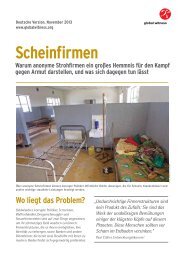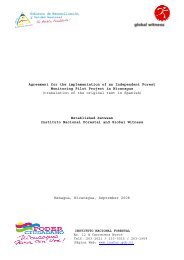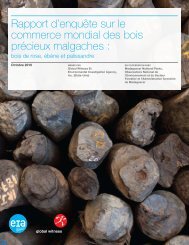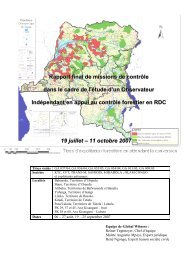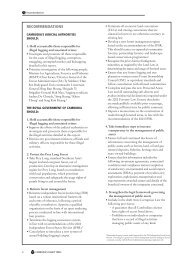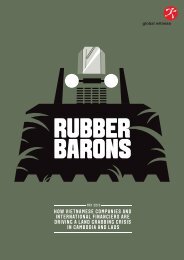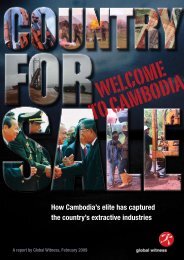03sep3 Conflict of Interests 60-89.pdf - Global Witness
03sep3 Conflict of Interests 60-89.pdf - Global Witness
03sep3 Conflict of Interests 60-89.pdf - Global Witness
Create successful ePaper yourself
Turn your PDF publications into a flip-book with our unique Google optimized e-Paper software.
18 KAREN STATE<br />
“The government <strong>of</strong> Burma also has forest acts. But the<br />
Burmese military regime has in its plan a strategy to<br />
eliminate the Karen people and so it uses logging<br />
concessions as a strategic tactic. The SPDC has given<br />
permission to the DKBA, private enterprise and its own<br />
units in those areas saying ‘We can reforest after deforestation,<br />
but it would be difficult to reform a government after its fall’” 127<br />
Karen Environmental and Social Action Network (KESAN), 2001<br />
The Karen are the largest ethnic family in Southeast<br />
Asia that have not gained recognition as an independent<br />
nation state. 4 Karen identity was significantly shaped<br />
during the colonial era when many joined the colonial<br />
army and large numbers converted to Christianity. It<br />
has been argued that the identification by many Karen<br />
with social and political advances under the British<br />
administration was the beginning <strong>of</strong> a dangerous ethnic<br />
polarisation between Karen and Burman communities<br />
that has continued to the present. 4 A series <strong>of</strong> violent<br />
events during and shortly after the Second World War,<br />
when government militias killed several thousand<br />
Karen, deepened the level <strong>of</strong> mistrust between the<br />
Karen and the dominant Burman majority.<br />
18.1 The Nature <strong>of</strong> <strong>Conflict</strong> in Karen State<br />
“There’s no question, the Burmese are out to crush the<br />
Karen because <strong>of</strong> the goldmine they are sitting on.” 266 Anon,<br />
diplomat, April 1989<br />
The Karen have been calling for an independent Karen<br />
State since the 1930s. But this did not result in full-scale<br />
conflict, between Karen forces and the government, until<br />
January 1949 when the government outlawed the Karen<br />
National Union (KNU) and Karen units defected from<br />
the Burmese Army. The 1947 Constitution was “riddled<br />
with anomalies,” 4 , Karen State had not been demarcated<br />
and there were serious disputes about where the<br />
boundaries should lie. In particular the Karen leadership<br />
was unhappy with a proposal that would give it control<br />
only over the portion <strong>of</strong> the eastern hills and no political<br />
representation in the Irrawaddy Delta area where a large<br />
number <strong>of</strong> Karens lived. But by June 1949 the KNU had<br />
established the Karen Free State <strong>of</strong> Kawthoolei, which<br />
included areas in the Irrawaddy Delta, Pegu Yomas,<br />
Tenasserim, and the town <strong>of</strong> Insein just outside Rangoon.<br />
Many areas in Karen State continue to be beset by<br />
violent conflict, which is characterised by low-level<br />
guerrilla activity by armed opposition groups and<br />
<strong>of</strong>fensives and forced depopulation by the SPDC. The main<br />
protagonists in the conflict, in addition to government<br />
forces, are the Democratic Karen Buddhist Army (DKBA)<br />
allied to the SPDC and the KNU. In addition there are<br />
several ceasefire groups that have split from the KNU. All<br />
<strong>of</strong> these groups are motivated, to varying degrees, by<br />
political ideologies and economic interests. The fight, in<br />
part at least, over natural resources has led directly to<br />
human rights abuses and environmental degradation.<br />
71<br />
Part Two: Logging in Burma / 18 Karen State<br />
A CONFLICT OF INTERESTS<br />
18.2 The Karen National Union (KNU)<br />
The KNU, formed in 1947, is the largest insurgent<br />
group in Burma not to have agreed a ceasefire.<br />
However after initial territorial gains it has gradually<br />
lost ground to government forces and has not held a<br />
town since the 1950s. The Four Cuts counter –<br />
insurgency campaign (see page 19) began in 1964 in the<br />
Irrawaddy Delta, spread to the Pegu Yomas Mountains<br />
and continues today. This campaign marked the<br />
beginning <strong>of</strong> widespread internal displacement in Karen<br />
State and led to the first wave <strong>of</strong> Karen refugees<br />
crossing to Thailand in the mid 1970s.<br />
The KNU retreated towards the mountains near<br />
Thailand where it established a ‘liberated zone’ along a<br />
400-mile stretch <strong>of</strong> the border. From 1974 to 1995,<br />
Mannerplaw near the confluence <strong>of</strong> the Salween and<br />
the Moei rivers was the headquarters <strong>of</strong> the KNU. After<br />
the DKBA split from the KNU, and the SLORC<br />
<strong>of</strong>fensives between 1995 and 1997, the KNU stopped<br />
defending fixed positions and re-adopted guerrilla tactics.<br />
The economy <strong>of</strong> the KNU was based on the border<br />
trade between Thailand and Burma upon which it levied a<br />
5-10% tax. The trade consisted <strong>of</strong> value-added consumer<br />
goods being imported into Burma and raw materials,<br />
including teak, cattle, precious stones and minerals going<br />
to Thailand. The BSPP isolationist policies prohibited the<br />
legal import <strong>of</strong> these goods, so they were only available on<br />
the black market, mostly via the insurgent-controlled<br />
borders. The KNU established trade gates in 1964 through<br />
which between one and two million baht ($40,000 and<br />
$80,000 at an average exchange rate in the 80s <strong>of</strong> 25 baht to<br />
the dollar) <strong>of</strong> trade passed daily. Not only did this cross<br />
border trade finance the ethnic insurgencies, it also made<br />
many Thai businessmen and military <strong>of</strong>ficers rich.<br />
At first sight the border trade would appear to have<br />
been disadvantageous to the BSPP/SLORC but it did<br />
have strategic military implications that would<br />
eventually undermine the KNU: it tied KNU forces to<br />
fixed positions that were easier to attack and meant that<br />
other areas were left largely undefended. It is also<br />
thought that there have been disputes within the KNU<br />
over control <strong>of</strong> the border trade and logging operations,<br />
and the proceeds which some thought were unfairly<br />
distributed (one <strong>of</strong> the factors that lead to the formation<br />
<strong>of</strong> the DKBA) (see page 72). From 1984 the<br />
BSPP/SLORC increasingly attacked the KNU’s border<br />
trade gates and by 1988 income from this trade was<br />
down by around <strong>60</strong>% at several <strong>of</strong> the gates. 267<br />
Much <strong>of</strong> the border trade has been formalised but<br />
the smuggling <strong>of</strong> many goods still banned by the SPDC<br />
is now largely controlled by the DKBA who control<br />
jetties and warehouses near the border. The view <strong>of</strong> one<br />
prominent SPDC <strong>of</strong>ficial is that the KNU and other<br />
insurgents along the Thai border are “basically<br />
economical bandits, who are living <strong>of</strong>f the people by<br />
intimidating them with acts <strong>of</strong> terror, while enjoying the<br />
support <strong>of</strong> the western democracies who are supposedly<br />
waging war on terrorism.” 268




